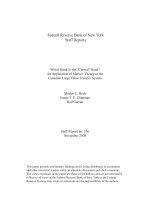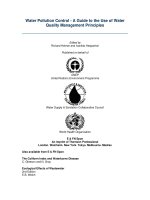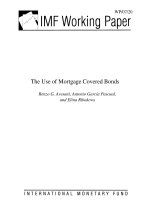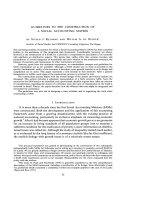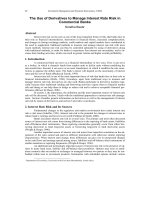Factors affecting patients satisfaction to the use of nurse call system at hospitals
Bạn đang xem bản rút gọn của tài liệu. Xem và tải ngay bản đầy đủ của tài liệu tại đây (1.45 MB, 61 trang )
~1~
HO CHI MINH CITY OPEN
UNIVERSITY
UNIVERSITÉ LIBRE DE BRUXELLES
SOLVAY BRUSSELS SCHOOL OF
ECONOMICS & MANAGEMENT
MBQPM4
H
KIM NGÂN
FACTORS AFFECTING PATIENT’S SATISFACTION
TO THE USE OF NURSE CALL SYSTEM AT
HOSPITALS
MASTER FINAL PROJECT
MASTER IN BUSINESS QUALITY AND PERFORMANCE MANAGEMENT
HO CHI MINH CITY
2014
~3~
STATEMENT OF AUTHENTICATION
I certified that the research would contribute to open an opportunity to develop
e-health technology in Viet Nam market as well as enhance the quality service of
patient’s care in Viet Nam.
I also certified that all helps and sources are acknowledged in the thesis.
~4~
ACKOWLEDGEMENT
“Stay hungry, stay foolish”-Steven Job
Although I know a little about Steven Job, I am inspired by his philosophy and
talent to build up Apple. His stories become a legend to me. To start and complete
something, it is necessary to “hungry” and “foolish” at the first moment. That is my
feeling since I have conducted the final thesis.
To get the value like that, I think I owe a debt of gratitude to people who have
loved, cared, and supported me. Therefore, I would like to express my first thanks
to parents for my present in life. Thanks for their love, their teaching during my
mature.
I would like to express my thanks to Dr. Jacques Martin who coaches me to
complete the final thesis successfully. His questions are the challenges for me to
correct the orientation of the thesis.
I would like to express my thanks to my sponsors - Ms. Nguyen Thi Hong
Thuy – Director of Viet Toan Phat Co., Ltd and Mr. Nguyen Van Nam – Technical
Expert of Viet Toan Phat Co., Ltd- who support me to conduct the survey in the
hospital, provide the specific information and give the value advises in the
healthcare sector.
I would like to express my sincere thanks to my great master, PhD. Nguyen
Thi Bach Tuyet - Folk Music Artist, who has taught me the value methods to
improve my performance in life.
Last, I would like to express my thanks to Solvay program, all professors,
coordinators and friends (Phan Vu An, Nguyen Thi Ngoc Le, Ngo Nguyen Thuy
Phuong Thao) who give me the encouragements and the supports in my master
journey.
HCMC, May 15th, 2014
Ho Kim Ngan
~5~
CONTENTS
STATEMENT OF AUTHENTICATION
ACKNOWLEDGEMENTS
CONTENT
LIST OF ABBREVIATIONS
LIST OF FIGURES
LIST OF TABLES
ABSTRACT
INTRODUCTION ……………………………………………………………….P11
1. Introduction of Nurse Calling System …………………………………..…P11
2. Research Problem, Question, Objectives and Scope………………….…P13
2.1. Research Problem………………………………………………………….P13
2.2. Research Question…………………………………………………………P14
2.3. Research Scope…………………………………………………………….P14
3. Thesis Structure…………………………………………………………….…P14
PART 1: LITERATURE REVIEW & RESEARCH FRAMEWORK…………P15
1. Technology Acceptance Model (TAM)……………………………………P15
2. Framework for consumers’ intention to use Nurse Calling System..P19
2.1 Categorization of Respondents……………………………………………P19
2.2 Perceived Usefulness………………………………………………………P20
2.2. Perceived Ease of Use……………………………………………………..P20
2.3. Perceived Credibility………………………………………………………..P21
2.4 Personal characteristics of consumers……………………………………P22
2.5. Framework of research……………………………………………………..P23
PART 2: METHODOLOGY AND RESEARCH DESIGN……………………P24
1. Methodology………………………………………………………………..…P24
1.1. Research Design…………………………………………………………….P24
1.2. Research Strategies…………………………………………………………P24
1.3. Research approach…………………………………………………………P24
2. Questionnaire and Sampling……………………………………………….P25
3. Data Analysis Procedures ………………………………………………..…P27
3.1. Descriptive statistics analysis……………………………………………….P28
3.2 Data Examining and Reliability Test of the Measurement Variables.…P28
PART 3: ANALYSIS & DISCUSSION………………………………………P29
1. Descriptive Analysis……………………………………………………….P29
1.1 Demographic characteristics of Respondents…………………….…P29
~6~
1.2 Behavioral Characteristics of Respondents on Use……………….…P32
2. Reliability Test…………………………………………………………….P34
2.1 Perceived Usefulness……………………………………………………P35
2.2 Perceived Ease of use……………………………………………………P37
2.3 Perceived Credibility…………………………………………………….…P38
3. Factors affecting Actual Use……………………………………………P40
3.1 Perceived Usefulness………………………………………………….…P41
3.2 Perceived Ease of use………………………………………………….…P42
3.3 Perceived Credibility……………………………………………………..…P43
4. Differences on Demographic Dimensions……………………………….P45
4.1 Gender of Respondents…………………………………………………….P45
4.2 Age-Group of Respondents……………………………………………….P46
CONCLUSION & RECOMMENDATIONS…………………………………...P47
REFERENCE………………………………………………………………….…P52
APPENDIX 1: QUESTIONAIRE……………………………………………….P54
APPENDIX 2: DEVICE AND FUNCTION……………………………………P57
APPENDIX 3: CASE STUDY………………………………...………………….P61
~7~
LIST OF ABBREVIATIONS
ABBREVIATION
DESCRIPTION
TAM
Technology Acceptance Model
NCS
Nurse Call System
TRA
Theory of Reasoned Action
PC
Perceived Credibility
PU
Perceived Usefulness
PEOU
Perceived Ease Of Use
ATU
Attitude Toward Using
TPB
Theory of Planned Behavior
SN
Subjective Norm
One Way ANOVA
One Way Analysis of Variance
~8~
LIST OF FIGURES
Figure 1: Market share of Nurse Call System in Viet Nam ………………...P12
Figure 2: Nurse call system capital yearly ………………………………….P13
Figure 3: Thesis structure ………………………………………………….P1 4
Figure 4: The Original TAM proposed by Fres Davis (Davis, 1986, p.24) ……P16
Figure 5: First modified version of TAM ………………………………….....P17
Figure 6: Final version of TAM ……………………………………………………P17
Figure 7: Research Framework …………………………………………………...P23
Figure 8: Occupation and Treat Time …………………………………………..P30
Figure 9 : % Respondents Treatment in Hospitals ………………………………..P30
Figure 10: Treatment time of 19% respondents said “NO” ……………………...P31
Figure 11: Diversity of Age & Gender …………………………………………..P31
Figure 12: Location Diversity …………………………………………………….P32
Figure 13: Numbers of Hospital Used …………………………………………P33
Figure 14: Nurse Call System Used ………………………………………………P34
Figure 15: Perceived Usefulness of Respondents ……………………………….P41
Figure 16: Perceived Ease of Use of Respondents ……………………………...P43
Figure 17: Perceived Credibility of Respondents…………………………………..P44
~9~
LIST OF TABLES
Table 1: General information in medical field in 2007 and 2008 ...................... P11
Table 2: Applications, participants, country and setting used for applying
TAM……………………………………………………………………………………..P19
Table 3: Cross Tabulation of EVER USED NURSE CALL SYSTEM &
OCCUPATION ………………………………………………………………………..P30
Table 4: General Hospital Information…..………………………………………….P32
Table 5: Reliability of Perceived Usefulness for Patients…..…………………….P35
Table 6: Reliability of Perceived Usefulness for Nurse or Aid staff …..…………P35
Table 7: Reliability of Perceived Usefulness for Nurse or Aid staff after removing
Q17 …………………………………………………………………...........................P36
Table 8: Reliability of Perceived Ease of Use for Patients ……………… ……..P37
Table 9: Reliability of Perceived Ease of Use for Patients after removing Q20..P37
Table 10: Reliability of Perceived Ease of Use for Nurses or Aid Staffs………..P38
Table 11: Reliability of Perceived Credibility for Patients ………………………...P38
Table 12: Reliability of Perceived Credibility for Nurses or Aid Staffs …………..P39
Table 13: The summary of items used for the further analysis ………………….P40
Table 14: The descriptive figures of selected patient variables …………………P40
Table 15: The descriptive figures of TAM scale …………………………………..P44
Table 16: T-test result of Gender of respondents …………………………………P45
Table 17: T-test result of Age group of respondents ……………………………..P46
~ 10 ~
ABSTRACT
Purpose
– The purpose of the study is to present a new look of consumer’s
satisfaction in using Nurse Calling Device in Viet Nam.
Design/Methodology/Approach
- The study is constructed base on Technology Acceptance Model (TAM) with
additional factor that are Perceived Usefulness, Perceived Ease-of-Use and
Perceived Creditability. Paper questionnaire is distributed to consumers. The
selected respondents are categorized into the age and sex. After reliability tests,
in-depth analysis is conducted to understand factors affecting consumer’s use and
independent sample t-tests are used to examine difference of demographic
dimensions.
Key Findings
- From 2007 to 2013, Government has planned to build general hospitals
installed these devices in every province. However, there is no research to study
about consumer’s satisfaction until now. This study attempts to choose an
appropriate model to evaluate consumer decision in the device, evaluate
factors affected to consumer intention to use these and contribute the
understanding of consumer’s demand to improve the device in the future.
Originality/Value
– The study provides the level of consumer’s satisfaction in using Nurse Calling
System in Vietnam context. However, the survey is only conducted in Ho Chi
Minh City. The result of the study may not cover all consumers’ level. Therefore,
the study will contribute to create a base for further study in the future.
Key words – Nurse call system, Perceived Usefulness, Perceived Ease-To-Use,
Perceived Creditability.
~ 11 ~
INTRODUCTION:
1. Introduction of nurse call system:
Nurse call system is the system that ensures hospital staffs can quickly
identify the location and level of the calls. The system also provides the means
that the patient can draw attention of a nurse from his bed whenever required. The
system has been applied in European countries for few decades.
In Viet Nam, population growth is average 1.05%1 from 2011 to 2013. Until
now, total population is 93 million. Total hospital is about 1062 with nearly 100,000
doctors and nurses. In below table 1, there is over 100 million times of visiting the
hospitals in Viet Nam every year.
Items
Average days of inpatient
Total doctors
Total nurse & aid
Times of inpatient treatment
Times of visiting hospital
Unit
day
person
person
times
times
2007
113
39,757
72,682
8,301,099
98,806,044
2008
113
40,505
75,756
8,908,751
103,844,948
Table 1 – General information in medical field in 2007 and 2008
Source: Ministry of Viet Nam healthcare, 2008
The figure shows that there is very high potential risk of medical errors for the
patient because of the conflict between the increasing of diseases and limit
medical employees. Since 2006, Viet Nam government had planned a strategy to
develop the hospital system with higher quality service.
The signal leads to create a competitive game attracting some players such
as Commax (Korea), Ackerman (German), and Aiphone (Taiwan), Uniphone and
so on. However, there is specific style for hospital projects in Viet Nam. The
product is only sold by the contractor that got the win in the tender. In fact, the
contractor joining in the tender has to match the basic requirement of experience,
human resource capacity and financial capacity. It means that the contractor has
experienced at least 1 year to conduct the same project with at least amount of
650 million VND. Resource capacity requires that the site supervisors have got
engineer degree and experienced at least 3 years at the same position in the site.
1
/>
~ 12 ~
Financial capacity requires that the average margin profit has been matched at
least 1.5 billion VND for 3 years continuously. Actually, the requirement is a part to
make a barrier for the contractors with limit capacity. Therefore, contractor is rarely
to match the requirement and join in the tender. That is the reason a contractor
becomes a distributor of nurse call system product in Viet Nam market.
In 2006, there are two players joining the game. They are Viet Toan Phat Co.,
Ltd (VTP) and Danh Dang Co.,Ltd. VTP was established to execute and provide
nurse call systems (Ackerman and Commax) in the hospitals and shared the
market from South to the centre. Danh Dang only distributed Commax product in
North.
The figure 1 shows that Ackerman product shares 40% marketplace and leads
at the top. In fact, Ackerman has been established since 1919 and developed in
European market for a long term. In the economic growth, the product has been
conducted many phases of innovation about the design and the function to provide
the better service to users. Conversely, Commax has been established since 1974
in Korea. The product is only developed in Asia market. If comparing with
European market, Commax development is lower.
Figure 1 – Market share of Nurse Call System in Viet Nam
Source, Viet Toan Phat Co., Ltd, 2014
In addition, VTP has executed more 402 hospital projects until 2014. Among of
them, French Vietnamese (FV) hospital is the first one installed Ackerman product
in Viet Nam. In figure 2, based on the profitability yearly, Ackerman is shared over
2
/>
~ 13 ~
60% projects from 2010 and the trend is predicted to develop more in Viet Nam
while Commax still keeps the same value.
Nurse Call Profitability Yearly
250,000
USD
200,000
150,000
100,000
50,000
2006
2007
2008
2009
2010
2011
2012
2013
2014
Ackerman 150,256 152,045 156,004 172,212 176,645 184,952 195,423 204,145 210,040
Commax
119,985 125,005 136,147 146,852 154,520 156,201 158,201 158,456 160,142
Figure 2: Nurse call system capital yearly
Source, Viet Toan Phat Co., Ltd, 2014
Finally, the growth of hospital contributes to create higher competitive
advantage for nurse-call-system players. It results a part of the impact to user’s
behavior.
2. Research problem, Question, Objectives and Scope:
2.1. Research problem:
There have been the researches to study nurse call system with different
purpose. However, the main aim is to provide the best service to prevent harms to
the patients. Moreover, the research was conducted in oversea. Since 2007, nurse
call system has been presented and developed in Viet Nam market and attracted
some players with different level. In addition, the device is installed in healthcare
sector that is one of the government styles. In the tender, the employer and
contractors make a decision to select the product. The seller cannot be presented.
Especially, there is no opportunity for the sellers to evaluate the user’s satisfaction
directly. The profit is only a measurement for their business in Viet Nam. The
benefit of consumer including hospital staffs and patients is not concerned in the
game. Especially, it is difficult for the seller or the manufacturer to set a strategy in
Viet Nam.
~ 14 ~
Therefore, the question has been called out “what are the opportunities to
develop sustainable strategy in Viet Nam market?”
2.2. Research question:
Different nation is different culture. The culture may be a factor to impact
user’s behavior to the device. In the game, the players are the employer, the
contractor, the sub-contractor and the distributor or seller. However, healthcare
sector is very specific. It creates a barrier for the sellers to develop the product.
To understanding market opportunities, in the possibility, the study is
addressed to find out the factors affecting patient’s satisfaction using the device.
The study is applied Technology Acceptance Model called TAM (Davis, 1985)
to evaluate the user’s behavior for the technical device. The objectives of
Usefulness and Ease to Use are implemented to study different user’s behavior
and how demographic dimensions influence their behavior.
2.3. Research scope:
The study aims to find the answer for above question and concentrates on
patient’s satisfaction. The patients are
Demographic dimensions
Gender
Aging
Location
Besides, the study is conducted on Ackerman and Commax product which are
shared high profit in Viet Nam market.
3. Thesis structure:
The study is structured into 5 parts in Figure 3.
Introduction
-Introduction
-Research
Part 1:
-Literature review
Part 2:
-Research design
-Methodology
Figure 3: Thesis structure
Part 3:
-Analysis
-Discussion
Conclusion &
Recommendation
~ 15 ~
PART 1: LITERATURE REVIEW & RESEARCH FRAMEWORK
The introduction has provided the background and problem area for this
research. In part 1, the theoretical framework that supports the purpose of this study
will be presented.
Undoubtedly, information technology contributes to develop standard living in
every field in modern society. From that, the concept of e- communication is
appeared in healthcare sector. It has been got the acceptance by users. Especially,
when people become patients, they place their trust in their health care providers and
the role of information technology takes more important to provide safety benefits by
enhancing communication and delivering decision-support (Barbara Van de Castle,
Jeongeun Kim, Mavilde L.G Pedreira, Abel Paiva, William Goossen, David W
Bates, 2004)
1. Technology Acceptance Model (TAM)
With growing technology needs in the 1970’s, and increasing failures of system
adoption in organizations, predicting system use became an area of interest for
many researchers. However, most of the studies carried out failed to produce
reliable measures that could explain system acceptance or rejection (Davis,
1989). In 1985, Fred Davis proposed Technology Acceptance Model (called
TAM) in his doctoral thesis at MIT Sloan School of Management (Davis, 1985).
He proposed that system use a response explained or predicted by user
motivation, which, in turn, is directly influenced by an external stimulus consisting
if the actual system features and capabilities.
The Technology Acceptance Model (TAM) is an information systems theory
stating how users come to accept and use a technology. The model suggests that
when users are presented with a new technology, a number of factors influence
their decision about how and when they will use it.
By relying on prior work by Fishbein and Ajzen (1975), who formulated the
Theory of Reasoned Action (TRA), and other related research studies, Davis
further refined his conceptual model to propose the Technology Acceptance
~ 16 ~
Model. Both TRA and TAM that have strong behavioral elements assume that
when someone forms an intention to act, that they will be free to act without
limitation.
In this proposal, Davis (1985) suggested that users’ motivation can be
explained by three factors: Perceived Ease of Use (PEOU), Perceived
Usefulness (PU) and Attitude Toward Using (ATU) the system. He hypothesized
that the attitude of user toward a system was a major determinant of whether the
user will actually use or reject system. The attitude of the user, in turn, was
considered to be influenced by 2 major beliefs: Perceived Ease of Use and
Perceived Usefulness, with perceived ease of use having a direct influence on
perceived usefulness. Finally, both these beliefs were hypothesized to be
influenced by the system design characteristics, represented by X1, X2 and X3 in
Figure 4
Figure 4: The Original TAM proposed by Fres Davis (Davis, 1986, p.24)
Later development of TAM would include behavioral intention as new
variable that would be directly influenced by perceived usefulness of a
system (Davis, Bagozzi and Warshaw, 1989). Davis et al. (1989) suggested
that there would be cases when, a given system which was perceived useful, an
individual might form a strong behavioral intention to use the system without
forming any attitude, this giving rise to a modified version of the TAM model as
illustrated in Figure 5.
~ 17 ~
Figure 5: First modified version of TAM (Davis, Bagozzi and Warshaw, 1989, p.985)
Davis, Bagozzi and Warshaw, (1989) used the above model to conduct a
longitude study to measure the intention of 107 users to use system after 1 hour
introduction system and again 14 weeks later. In both cases, their results
indicated a strong correlation between reported intention and self-reported
system usage with perceived usefulness responsible for the greatest influence on
the people’s intention. However, Perceived Ease of Use was found to have a
small but significant effect on behavioral intention that later subsided over time.
But the main finding was that both Perceived Usefulness and Perceived Ease of
Use were found to have a direct influence on behavioral intention, thus
eliminating the need for the attitude construct from model shown on Figure 5.
The resultant model is shown in Figure 6.
Figure 6 - Final version of TAM (Venkatesh & Davis, 1996, p.543)
Thus, by eliminating the attitude construct and introducing the behavioral
~ 18 ~
intention construct, the result obtained for the direct influence of perceived
usefulness on actual system use. At the same time, removing the attitude
variable eliminated any unexplained direct influence observed from system
characteristics to attitude variable. An additional change brought to the original
TAM model, was the consideration if other factors, referred to as external
variables that might influence the beliefs of a person towards a system.
External variables typically include system characteristics, user training, user
participation in design and the nature of the implementation process (Vankatesh
& Davis, 1996).
By the final version in place, Chuttur M.Y. (2009) urged that future research led
to replicate TAM and test its propositions and possible limitations; compare TAM
with other models such as the Theory of Reasoned Action (TRA) and the Theory
of Planned Behavior (TPB); adapt TAM for the various setting such as mandatory
scenarios, different applications, cultures. In addition, future research led to extend
the model including other variables such as subjective norm (SN), extrinsic
motivation, and playfulness and so on.
With more than 700 citations to Davis’s original proposal for TAM, Davis’s
research (Davis, 1989) has been adapted and extended in many ways. To date,
there have been several attempts to consolidate the results obtained from these
studies. The most recent one is by Yousafzai, Foxall and Pallister (2007) who did
meta-analysis of 145 articles publishing on TAM. Table 2 highlights some main
applications, participations, countries and setting for which TAM was used
(Chuttur M.Y., 2009)
~ 19 ~
Table 2 - Applications, participants, country and setting used for applying TAM (Yousafzai
et al., 2007, Sharp, 2006, King et al., 2006, Ma et al, 2004, Lee et al. 2003 and Legris et at.,
2003)
2. Framework for consumers’ intention to use Nurse Calling System
2.1 Categorization of Respondents:
Fatma Pakdil and Timothy N. Harwood (2005) indicated that patient
satisfaction is one of key success indicator to measure the quality of healthcare.
At the same view, Mikeal Rahmqvist (2001) argues that background factors such
as age, gender, health status are affected on the comparison of patient
satisfaction and medical specialties. Additionally, JL Campell, J Ramsay and J
Green (2001) showed that the aspects of care quality are measured by patient’s
evaluation. Their work also studied that the patient characteristics such as age,
gender, socioeconomic are variable to influence the result of the assessment of
healthcare. The different variation contributes to different response on the
system use.
Therefore, Respondents of the research is categorized two groups, age and
gender. It leads to different behavioral use of consumers. The aim is to study
what aspect of care quality is impacted by different characteristics. By this
categorization, study aims to clarify the understanding of 2 groups of
respondents under 3 dimensions, Perceived Usefulness, Perceived Ease-of-Use
and Perceived Creditability.
~ 20 ~
2.2 Perceived Usefulness:
Perceived of Usefulness that is the first determinant of TAM (Davis, 1985) is
defined “The degree to which an individual believes that using particular system
would enhance or improve his or her job performance”. Usefulness that is
indicated on performance or productivity improvement refers to consumers’
perceptions regarding outcome of experience (Mosuwé et al., 2004). Besides,
Usefulness is influenced by Ease-of-Use to determine consumers’ attitude
toward using, because the easier a technology is to use, the more useful it can
be (Venkatesh, 2000; Dabholkar, 1996; Davis et al., 1989). Studies outside and
within the consumer health informatics discipline have consistently found that
perceived usefulness of a technology is associated with the acceptance of the
technology. This suggests that patients will be more likely to accept the
technology if they believe that the technology is useful as it can convey health
value or facilitate self-management (Calvin K L Or, Ben-Tzion Karsh, Dolores J
Severtson, et al, 2011).
In this study, Perceived Usefulness is defines as a Physical Usefulness.
Physical Usefulness is the convenience and effectiveness brought when patients
use Nurse Call System. Warren J Winkelman, Kevin J Leonard and Peter G
Rossos (2005) argued that there is a distinction for a patient from “look at” to
“use” to the health care device. The way that the patient finds the trust to use the
system depends on the physical feature and function of the system. The
integration between the patient and the system is expected to gain the
performance and the value.
Totally, nurse call system is believed to provide high quality of supportive
health information for consumers. People are expected to adapt the system
physically including the effectiveness, productivity, performance and satisfaction.
2.2. Perceived Ease of Use:
The second determinant of TAM (Davis, 1985) is Perceived Ease of Use
which is “The degree to which an individual believes that using particular system
would be free of physical and mental effort”. Ease-of-Use is about the extent to
~ 21 ~
which a person believes that using new technology will be free of effort. Whereas
Usefulness referred to consumers’ perceptions regarding the outcome of the
experience, Ease-of-Use refers to their perceptions regarding the process
leading to the outcome. In a simplified manner, it can be stated that Usefulness
reflects how effective interaction on Nurse call system is helping consumers to
accomplish their task with the best convenience, and Ease-of-Use is how easy
the use of Nurse call system is. This suggests that patients are more likely to
accept Nurse call system and perceive the technology as useful if they feel that
the technology is easy to use (Calvin K L Or, Ben-Tzion Karsh, Dolores J
Severtson, et al, 2011).
According to TAM, the value of perceived ease-to-use is identified that
patients become a little confused when using the system. Their interaction with
the system is easy to understand at the first introduction. The hospital staffs
could recover the errors easily during interacting with the system. The easier and
more effortless a technology is, the more likely consumers intend to use this
technology. These include differences in ease of use, usage convenience,
reliability, ability to provide a record of the transaction, leverage potential, retailer
acceptance and transaction speed ((Jackie L. Boucher, 2010).
Finally, the research attempts to study the human perception of perceived
ease to use through the interaction between the patient and the system easily.
The patient is expected to pay the effortlessness to perform their tasks.
2.3. Perceived Credibility:
Bauer (1960) introduced the concept of perceived credibility in terms of the
confidence and consequences associated with a consumer’s actions. In addition,
perceived credibility is the extent to which one partner believes that the other
partner has the required expertise to perform the job effectively and reliably
(Ganesan, 1994). According to Jacoby and Kaplan (1972), perceived credibility
is defined as the degree to which a user feels the certainty and pleasant
consequences of using an electronic application service, when there is no
financial risk, physical risk, functional risk, social risk, time-loss risk, opportunity
cost risk, and information risk.
~ 22 ~
Perceived Creditability is major factor affecting to human behavior to
continue using of any new technology applications. It refers to the 2 significant
dimensions – design (safety) and data (care documentation) - that are identified
across many studies as effecting user’s practice to adopt health information
technology (Marianne Zachariah, Shobha Phansalkar, Hanna M Seidling, et al.,
2011). Perceived risk in customer behavior research was introduced as any
action of a consumer may lead to unpleasant consequences. In other studies,
perceived risk is the consumer’s expectation of suffering loss in pursuit of
desired outcome. With this definition, perceived risk is a multi-dimensional
construct with overall risk that is divided into financial psychological,
performance, physical and social loss, or risk of losing personal control (money,
data and times) and system failure.
Safety relates to the risk associated with the feature of health information
system. No one can refuse the role of risk in the decision to adopt new
technology system. Depending on different model, the risk level is defined
differently. In Nurse call system, all devices are connected through electrical
signal. Moreover, patient is a person touching directly on the devices. Therefore,
safety is the important credibility concerned.
Besides, care documentation relates to the risk of the function of the system.
Data are expected to provide for suitable purpose. To the new system, the error
is sometimes occurred due to the system failure or human knowledge. It results
the information is transferred wrong or missed. It leads to reduce the satisfaction
value. Totally, care documentation refers to quick present in the patient room
when making a call by nurse call system.
As a summary, study will consider consumer awareness on safety and quick
response.
2.4 Personal characteristics of consumers:
Christian Homburg* and Annette Giering (2001) studied that personal
characteristics influences the relationship between customer satisfaction and
loyalty. Besides, Lancaster (1966) noted that characteristics is the driver of
~ 23 ~
consumer utility or attributes. The attributes are gender, age, nationality and so
on. Triandis (1979) described characteristics as an individual’s positive or
negative behavior towards innovation adaptation.
TAM suggests that attitude is based on the salient beliefs that a person has
about the consequences of a given behavior and his or her evaluation of those
consequences. Davis (1993) put forward that consumers’ characteristic toward
technology system first associated with the direct possessions of relevant
system features. System features can be consumers’ characteristic of functional
and utilitarian dimensions, like ease of use and usefulness (Menon & Kahn,
2002; Childers et al., 2001; Mathwick et al., 2001).
Finally, this study examines the different demographic factors including
gender and age on three dimensions Perceived Usefulness, Perceived Ease of
Use and Perceived Credibility.
2.5. Framework of research:
For developing an in-depth understanding of consumer use of nurse call
system, a framework built is based on the previous research on consumer
adoption of new health technology services. The core constructs of framework are
adapted to Technology Acceptance Model by Davis (1989), an influential
research model in the information systems field. TAM constructs are used as
a basis for research framework.
Based on review of literature, the theoretical framework for research are
Personal characteristics:
Gender, Age,
Demographic distribution
proposed as Figure 7 below
Perceived Usefulness
Perceived Ease of Use
Perceived Credibility
Figure 7: Research Framework
Actual use of Nurse
Call System (Patient
satisfaction) at
hospital
~ 24 ~
PART 2: METHODOLOGY AND RESEARCH DESIGN
1. Methodology:
1.1. Research design:
Research design is the framework where data are collected and analyzed in
the study. Burn and Bush (2006) indicated that there are 3 types including
exploratory, descriptive and causal. Exploratory is a step to find out the ideas.
Descriptive is to set a method to study the relationships among variables. In the
research framework, perceived usefulness, perceived ease of use and perceived
credibility are independent variable, actual use of Nurse Call System is dependent
variables. Last, causal aims to define the relationship between the independent
variables and dependent variable as a correlation study (Cooper and Schindler,
2003).
In the study, correlation research has been selected to figure out the
appropriate answer to the research question. The researcher uses co relational
study to identify the existence of relationships between the variables and measure
a degree among them. The findings will contributes to understand the factors
affecting consumer satisfaction using Nurse Call System in the present as well as
its barriers for further investigation.
1.2. Research strategies:
A research design is a prediction of the consumer responses on large scale.
As the result, the quantitative approach is applied. It quantifies data and uses
statistical analysis to fulfill the understanding of external causes that support to
answer the questions. The result from statistical method is reliable to decide which
factors are affecting to consumers habits.
1.3. Research approach:
There are two different research approaches: primary research, which data
have not collected yet, and secondary research, which summary, collection of
existing research. This study is applied secondary research because data are
obtained the information quickly and inexpensively, providing background
information, identifying the concept, data, and terminology for primary research
(Burn and Bush, 2006, p.159).
~ 25 ~
The research aims to study general circumstance of Nurse Call System in Viet
Nam context. The researcher gathers the information from existed patients in the
hospitals. Data are collected through questionnaire survey. All participants
conduct the survey by questionnaire paper. They all are voluntary.
List of key terms are developed such as “Technology Acceptance Model”,
“Nurse Call System”, “Patient satisfaction”, etc. The sources and literature review
include academy journals, books, Viet Toan Phat Co., Ltd. In addition, the data is
limit because the research is conducted in specific sector. Therefore, the interview
of sponsors, experts, nurse and outpatients are conducted to get more information
to support the research.
2. Questionnaire and Sampling:
The questionnaire consists of three sections. The first section gathers the
general information to classify gender, age and demographic information as
external variables that influence the formulation of relevant perceptions. The
second asks consumers about the Perceived Usefulness, Perceived Credibility.
The third concentrates on Perceived Ease-of-Use. In the second and third part,
there are some questions for nurses or aid staff to get more information as
expert’s idea. Satisfaction is divided three levels: Agree; Disagree and Neural.
Question table:
Question
ID
Objective item
Question 1
Q1
Demographic information
Question 2
Q2
Demographic information
Question 3
Q3
Demographic information
Question 4
Q4
Demographic information
Question 5
Q5
Demographic information
Question 6
Q6
Demographic information
Description
Study
how
variables
do
affects
external
the
independent variables and
dependent variable.
~ 26 ~
Question 7
Q7
Demographic information
Question 8
Q8
Perceived Usefulness
Question 9
Q9
Perceived Usefulness
Question 10
Q10
Perceived Usefulness
Question 11
Q11
Perceived Usefulness
Question 14
Q14
Perceived Usefulness
Question 17
Q17
Perceived Usefulness
Question 18
Q18
Perceived Usefulness
Question 19
Q19
Perceived Usefulness
Question 20
Q20
Perceived Ease-of-Use
Question 21
Q21
Perceived Ease-of-Use
Question 22
Q22
Perceived Ease-of-Use
Question 23
Q23
Perceived Ease-of-Use
Question 24
Q24
Perceived Ease-of-Use
Question 12
Q12
Perceived Credibility
Question 13
Q13
Study how useful Nurse Call
System is to respondents.
Q8 – Q11: patient
Q14,17,18,19: nurse or aid
staff
Study how easily Nurse Call
System is to respondents.
Q21,22: patient
Q23,24: nurse or aid staff
Study how safe Nurse Call
System
affects
to
respondents.
Q12,13: patient
Question 15
Q15
Perceived Credibility
Question 16
Q16
Perceived Credibility
Study
how
smooth
Call
information is transferred.
Q15,16: nurse or aid staff


